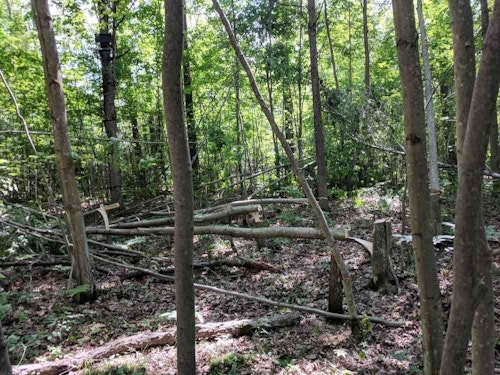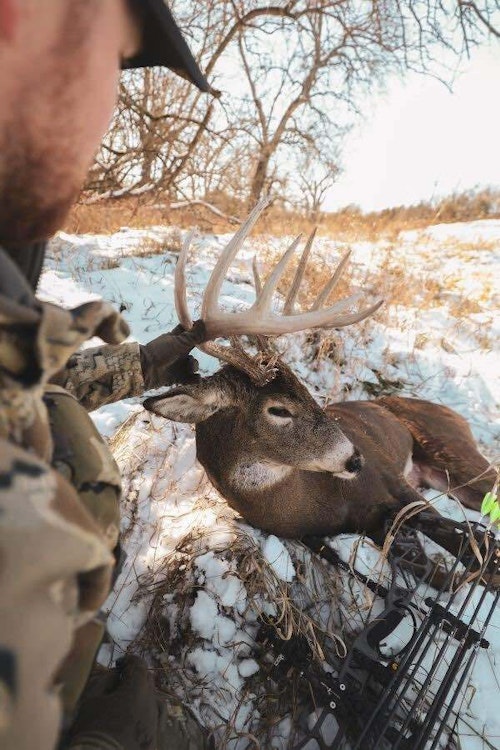
The best way to ensure mature bucks stay on your property during daylight is providing them with a sanctuary of thick bedding cover. (Photo: iStock)
Countless articles have been written about bedding areas — how to hunt them, where to find them, and so on. But what makes a deer bed where it does? Do deer pick one area over another, or do they simply lay down when they get tired? If a hunter knows how to create a bedding area that whitetails will actually use, then he or she can use that to their advantage to keep deer on their property and to have a chance at successfully harvesting a mature whitetail.
A whitetail puts a good amount of thought into choosing a bedding area. And there are things you can do to make a specific part of your hunting property more appealing to use as a bedding area. I for one would rather have deer spending their days bedded on my property rather than the neighbor's property.
For a deer to want to bed in any area, it must feel safe to the deer. This is best done by creating a sanctuary. A sanctuary should never be stepped foot on unless it is to recover a wounded animal. That means no scouting (including regular trail cam checks) and shed hunting. I set cameras on trails leading to and from a sanctuary.
Just a small piece of your total acreage can serve as a sanctuary; as little as 1 or 2 acres will work fine. If you have a bigger chunk of property that will allow you to create multiple bedding areas, all the better. Once a sanctuary is in place, and everybody who has access to the property knows about it being off-limits, the next step is making it a place whitetails want to bed.
Predator Control
Not only does the area have to be a safe place from human intruders, but four-legged predators, too. Coyotes and bobcats are the only other threat besides humans that a whitetail has in most parts of the country. Luckily, it is possible to reduce the number of predators on your property.
Fortunately, I love to trap, and trapping is a remarkably effective method to control coyotes and bobcats, but trapping is not for everyone. Trapping is not easy, it takes time to learn, and once you learn to trap it takes a lot of time to see results. Trappers are always looking for new ground to trap. There are not a lot of trappers anymore, so it will take some networking to find one, but they are out there.

Maybe hunting for predators is more your thing. Predator hunting can be done for several months out of the year, and even year-round in some states. Also, I never pass up the opportunity to shoot a coyote or bobcat while deer hunting, either. I have been told the shot will end the hunt, but a deer is not going to come in with a coyote or bobcat in the area. Plus, I shot a coyote, and 15 minutes later shot a whitetail.
Trapping and hunting predators improve bedding areas, increases whitetail fawn survival rate, and if the furbearer was taken during winter with a prime pelt, it can be sold for extra cash.
Hinge-Cutting
A tree that is hinge-cut will provide good bedding cover, and even food for whitetails. To hinge-cut a tree, cut halfway through a small tree 5 to 6 feet above the ground. The tree will drop to the ground, continue to grow, and offer browse for the deer to feed on. (See sidebar for more tips.)
More is not always better, so plan your hinge-cutting accordingly. In my experience, bedded deer don’t like so many hinge-cut trees that they can’t see downwind for possible danger. I prefer to drop trees so they criss-cross one another. Hinge-cutting trees on south-facing slopes also lets the sun's rays get through to where the deer are, something deer crave in the frosty winter months.
Sometimes a few trees need to be taken out completely. In the fall, deer often prefer to bed in tall grassy areas. To grow these grasses, it takes sunlight. Cutting a few trees to allow the sun to reach the forest floor will let the grasses grow and provide a nice bed. New tree growth will also flourish when you remove some mature trees, increasing the amount of bedding cover and browse.

Use Observation Stands
Before creating a place where whitetails will want to bed, think ahead in regards to where you will be likely hunting, how you will get to and from your stand, and how you will hunt the area. That said, don’t assume your planning is perfect.
After creating a bedding sanctuary, use observation stands to ultimately pinpoint the exact tree or trees to hang your stand(s). This can be done in the summer months and throughout the deer season. A perfect observation stand location will offer an unobstructed view of where you think the deer will be as they exit and enter the sanctuary. Of course, pay attention to wind direction; at no time do you want human odor blowing into the bedding area. Ideally, you can observe activity from at least 100 yards downwind of the sanctuary; 200 yards is even better.
Every time you hang an observation stand, treat it like you are putting up a stand for a hunt. Look for trails and land features that could allow you to fill your tag, but remember your goal is to pattern deer entering and exiting the sanctuary in the distance. Harvesting a deer from an observation stand should be looked at as a bonus. Take precautions such as scent control, entry and exit strategies, and good camouflage when in an observation stand.

Holding Deer Is Key
It does not take a sizable chunk of your property to create a bedding area. If you can create two or three bedding areas, then the mature bucks will choose the best for themselves, and let the smaller bucks have the others. Instead of letting the smaller bucks bed on the other side of the fence, I want to have a place for them on my property, too.
Don’t be tempted to check whether deer are using a newly completed bedding area. Be confident and know that if you make the area more inviting to be used as a bedding area, deer will take full advantage of it.
It does not take a lot of time and money to create a bedding area. A few hours (depending on size), a small saw (depending on tree sizes), and even some coyote hunting or trapping, and you can create an area deer want to bed.
Be patient. That is the key to creating a successful bedding area. Results won’t happen overnight, but the sooner you get the ball rolling, the sooner whitetails will feel comfortable taking naps on your property.
Sidebar: Hinge-Cutting Trees With the Habitat Hook
By Nick Nation
In 2010, I was first introduced to the practice of hinge-cutting. As explained in this article, hinge-cutting is the process by which smaller diameter trees are cut half to three-quarters of the way through the tree and then pushed or pulled over to a horizontal position. When the location of the cut (hinge) stays intact and receives enough sunlight, the tree will continue to grow for years to come. This is a rapidly growing technique used by many landowners who seek to improve their habitat for deer which can be done easily with some general habitat knowledge and the right tools.
When done correctly, hinge-cutting is extremely effective at enhancing your property for deer and other wildlife. It can be used to create buck and doe bedding, create travel corridors, screen hunter access movements, remove forest canopy for forest regeneration, screen property borders, and other features that may fit into your habitat plan. When I say “plan,” I’m referring to the thought process put forward BEFORE you go in and create a tornado zone impassible to deer. Plan out your stand locations and access trails first using topo or aerial maps. Then map out where you want food sources, bedding, and travel corridors. Once a plan is in place, start your hinge-cutting based on that plan.

To hinge-cut safely and correctly you MUST have the proper personal protective equipment and the right tools. One of my absolute favorite tools is what I call the Habitat Hook (www.habitathook.com). When I first started hinge-cutting there was no specific tool available that could help me hinge-cut effectively. Attempting to hinge-cut any amount of trees was extremely labor intensive, and I had poor results because I couldn’t consistently keep the hinge together. The Habitat Hook helps give the leverage required to push or pull against a tree that has had a hinge-cut into it. More leverage means a shallower cut, which allows more of the tree’s cambium layer to stay intact. This will give the tree a much higher success and growth rate.
When looking to create hinge-cut areas, using a top-notch handsaw or chainsaw (or larger trees) and the Habitat Hook in combination works great.
Working with a friend allows one person to be cutting the hinges while the other uses the Habitat Hook to push over the trees and then pull into position if needed. Trees under 4 inches in diameter are easy to push or pull over once the hinge is cut. I prefer to push over larger trees rather than pull them because it’s easier to apply constant pressure against the tree rather than pulling, and it helps prevent the Habitat Hook from getting caught up in a falling tree. If the hook gets caught in a tree when pulling, there is a chance of it getting bent by the tree.
Extendable Habitat Hook models are the most universal because they can be used in tight areas at 7 feet long or extended to 13 feet when the most leverage possible is required.
Sidebar: Hunting Doe Bedding Areas
By Jason Houser
Hunting near doe bedding areas has delivered more rutting bucks for me than all other stand placement strategies combined. I find it to be a deadly tactic. The following guidelines help tremendously.
- Not all doe bedding areas can be hunted effectively. For example, bedding areas based on topography, such as ridges and points, often don’t allow hunters to slip in without being seen. Furthermore, the lack of at least one defined edge makes it very hit or miss unless paired with some form of a pinch-point.
- The easiest doe bedding areas to hunt are those with a defined edge, such as a cedar swamp, thicket, or overgrown CRP field. Here, bucks can skirt the edge, scent-checking both the trails and female deer inside. This allows them to swiftly and effectively scent-check entire doe groups.
- When all else is equal, hunt the downwind side of a doe bedding area. Because a buck can scent-check all the occupants with one downwind pass, this is the route he takes most often.
- Most times, bucks cruise the edge of the doe bedding area only 5 to 20 yards off its edge. Therefore, stands placed approximately 30 yards out keep most bucks upwind of your stand and also provide shots at those cruising as far out as 60 or more yards.
- Finally, when selecting a tree on the prevailing downwind side, look to cover either the best entrance/exit trail, a well-used pinch, or the most impressive scrape in the area. Follow these guidelines and you are well on your way to filling that tag with a rutting buck.





